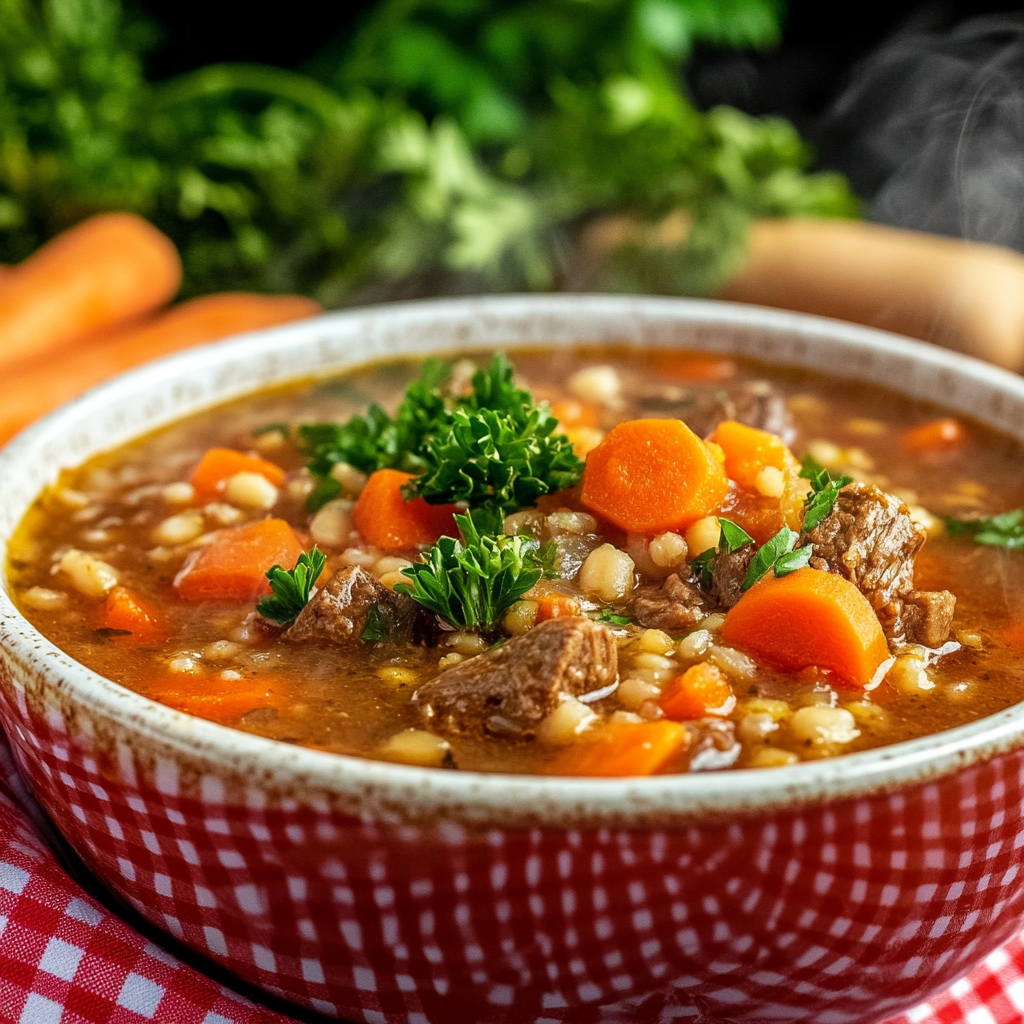Hearty Vegetable Beef & Barley Soup

Share
This rich and comforting vegetable beef & barley soup features tender beef, hearty vegetables, and nutty barley. It’s perfect for a cozy meal on chilly days. The addition of fresh parsley adds brightness, and the beef broth creates a savory depth. If the soup becomes too thick, simply add water to adjust the consistency.
Did You Know?
Barley is an ancient grain that has been cultivated for thousands of years. It’s packed with fiber, which helps digestion and keeps you feeling full. In this soup, pearl barley absorbs the flavors of the broth and provides a satisfying, chewy texture that complements the tender beef and vegetables.
Yield:
8 servings
Ingredients:
For the Soup:
1 lb beef stew meat, cut into 1-inch cubes
1 tablespoon olive oil
Salt and pepper, to taste
1 large onion, chopped
1 garlic clove, minced (optional)
3 carrots, peeled and sliced
2 medium potatoes, diced
1 can (14.5 oz) stewed tomatoes
6 cups beef broth
1/2 cup pearl barley, rinsed
2 tablespoons fresh parsley, chopped (or 1 tablespoon dried)
1 bay leaf
Instructions:
Brown the beef: Heat olive oil in a large soup pot over medium heat. Season the beef with salt and pepper, then add to the pot. Cook until browned on all sides, about 5-7 minutes. Remove the beef from the pot and set aside.
Personal Tip: Browning the beef first adds depth to the soup's flavor, creating a richer base.
Sauté the vegetables: In the same pot, add the chopped onion and sauté until softened, about 5 minutes. Add the garlic, carrots, and potatoes, cooking for another 3-4 minutes until they begin to soften.
Personal Tip: Sautéing the vegetables before adding liquid enhances their natural sweetness.
Combine the ingredients: Return the browned beef to the pot. Add the stewed tomatoes, beef broth, barley, bay leaf, and parsley. Stir to combine.
Personal Tip: Crushed stewed tomatoes add a richer texture to the broth. Use your spoon to break them up in the pot for a smoother consistency.
Simmer the soup: Bring the mixture to a boil, then reduce the heat and let it simmer, covered, for 45-60 minutes, or until the beef is tender and the barley is cooked through. Stir occasionally.
Personal Tip: If the soup becomes too thick while simmering, add water in 1/2-cup increments until the desired consistency is reached.
Season to taste: Taste and adjust the seasoning with salt and pepper as needed. Remove the bay leaf before serving.
Personal Tip: A squeeze of lemon juice can brighten the flavors just before serving.
Serve: Ladle the hot soup into bowls and garnish with extra chopped parsley if desired.
Nutritional Information (Per Serving):
Calories: 320, Protein: 20g, Carbohydrates: 30g, Fiber: 5g, Net Carbohydrates: 25g, Fat: 12g, Saturated Fat: 4g, Cholesterol: 60mg, Sodium: 580mg, Sugars: 5g, Glycemic Index: Medium
Kitchen Tips, Great Ideas, How to Save Money
-
Use beef broth: Beef broth adds a deep, savory flavor that pairs perfectly with the richness of the beef and barley.
-
Stretch the beef: Use less beef and add more barley or vegetables to make the soup more economical without sacrificing heartiness.
-
Boost with greens: Stir in chopped kale or spinach during the last 10 minutes of cooking for added nutrients.
-
Adjust consistency: If the soup becomes too thick, add water or more broth in small increments until it reaches your desired thickness.
-
Sauté for flavor: Always sauté onions and garlic before adding them to soups to develop a sweeter, richer taste.
-
Freeze leftovers: This soup freezes well. Store individual portions in airtight containers for up to 3 months.
-
Budget-friendly veggies: Carrots and potatoes are economical, but you can add celery or turnips for extra flavor without significantly increasing cost.
-
Store herbs properly: Store fresh parsley in a jar with water in the fridge to extend its life, keeping it fresh for garnishing.
-
Canned tomatoes: Stewed tomatoes add a deeper flavor, but you can also use crushed tomatoes if that’s what you have on hand.
-
Layer the flavors: Build flavor by browning the beef and sautéing the vegetables before adding the liquids. It makes a big difference in taste.
Let’s Learn About Barley: Pearl vs. Hulled
Pearl barley and hulled barley are two common varieties, but they differ in texture and cooking time. Pearl barley is polished, making it quicker to cook and softer in soups. Hulled barley retains more of its bran layer, offering a slightly chewier texture and more nutrients, but takes longer to cook. Pearl barley is ideal for soups like this one because it absorbs the flavors of the broth without becoming mushy. When using pearl barley, it’s important to rinse it before adding it to the soup to remove excess starch and keep the broth clear.


